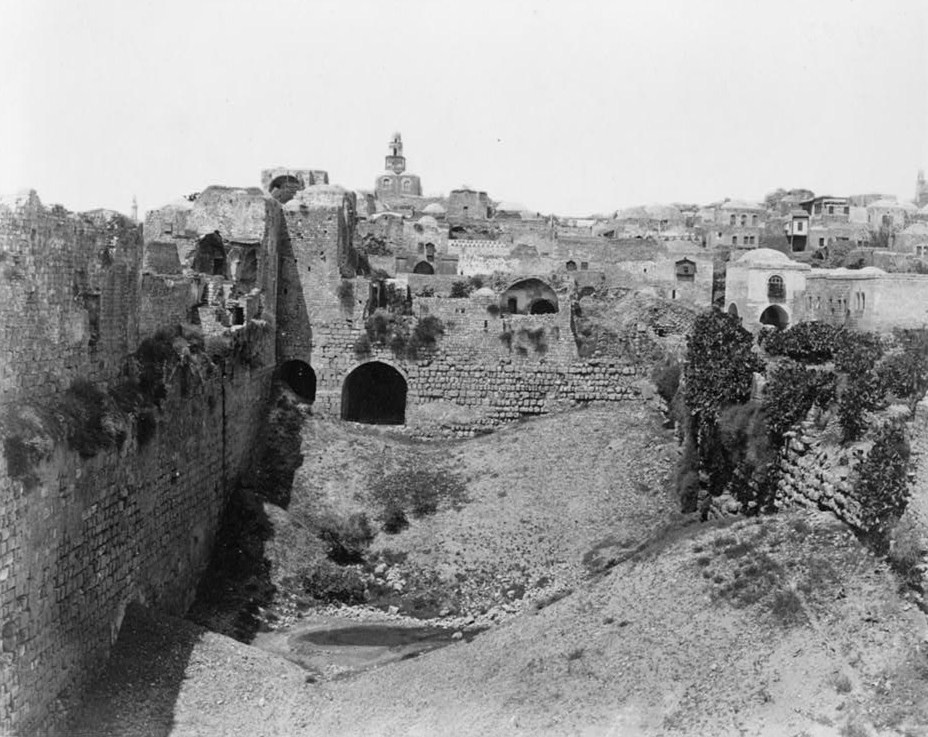HOME / Table of Contents = Civilizations - Cultures - Areas - Regions - Prehistory
Other Archaeological Sites / The Neolithic of the Levant (500 Page Book Online)
Ancient Jerusalem

Selected Excerpt on Jerusalem
Excavations at Jerusalem by Kathleen Kenyon
Antiquity: Volume XXXVI (June 1962)
Preface: Undoubtedly Jewish antiquities comprise a prominent part of Jerusalemís archaeological
heritage but there is much more. For one thing settlement around the Gihon
spring began as early as 5000 BCE, four millennia before King David, and the
first evidence for the cityís rise to prominence comes when the city was inhabited by
Canaanites around 1700 BCE (1).

 Holy City in Palestine occupied for more than 4000 years. Many excavations have taken place since 1860 but because of the long history of destruction and rebuilding on the site it has been difficult to reconstruct thc development of the city. Sporadic traces of 4th and 3rd millennium BC occupation occur but the first substantial settlement with a town wall belongs to the 2nd millennium BC. The town of this period was on the spur of Ophel in the southeastern part of the city and when David captured Jerusalem from the Jebusites circa 1000 BC he retained the existing defences. Solomon built his temple and palace on the higher ridge to the north. In the 8th - 7th centuries BC part of the western ridge was also incorporated in the town walls though the southeast part of this ridge was not included until the time of Herod Agrippa (AD 40 - 44) in a second phase of growth after the destruction by the Neo-Babylonians in 587 BC and later resettlement. Few early buildings survive; one exception is the rock cut water tunnel constructcd by Hezekiah in the late 8th century BC. Some remains of the Herodian and Roman period also survive ... (AHSFC).
Holy City in Palestine occupied for more than 4000 years. Many excavations have taken place since 1860 but because of the long history of destruction and rebuilding on the site it has been difficult to reconstruct thc development of the city. Sporadic traces of 4th and 3rd millennium BC occupation occur but the first substantial settlement with a town wall belongs to the 2nd millennium BC. The town of this period was on the spur of Ophel in the southeastern part of the city and when David captured Jerusalem from the Jebusites circa 1000 BC he retained the existing defences. Solomon built his temple and palace on the higher ridge to the north. In the 8th - 7th centuries BC part of the western ridge was also incorporated in the town walls though the southeast part of this ridge was not included until the time of Herod Agrippa (AD 40 - 44) in a second phase of growth after the destruction by the Neo-Babylonians in 587 BC and later resettlement. Few early buildings survive; one exception is the rock cut water tunnel constructcd by Hezekiah in the late 8th century BC. Some remains of the Herodian and Roman period also survive ... (AHSFC).

Photograph from the American Colony (Jerusalem)

One of the earliest photographs of Jews praying at the Western Wall in the 1870s (Felix Bonfils)

Birket Israel : The empty reservoir in the late 19th century (Felix Bonfils circa 1880)

JERUSALEM IN BIBLE TIMES: III THE SPRINGS AND POOLS OF ANCIENT JERUSALEM
PROFESSOR LEWIS BAYLES PATON (Hartford Theological Seminary) PDF 1.9 MB
(1) Towards an Inclusive Archaeology in Jerusalem: The Case of Silwan/The City of David (2009)
Raphael Greenberg (Tel Aviv University) PDF
The History of the Ancient Near East Electronic Compendium






